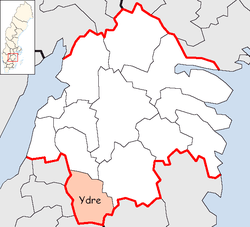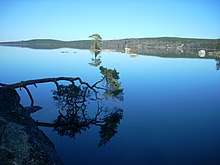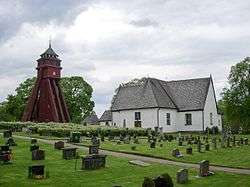Ydre Municipality
Ydre Municipality (Ydre kommun) is a municipality in Östergötland County, southeast Sweden. The municipal seat is located in the town of Österbymo.
Ydre Municipality Ydre kommun | |
|---|---|
 Coat of arms | |
 | |
| Country | Sweden |
| County | Östergötland County |
| Seat | Österbymo |
| Area | |
| • Total | 778.62 km2 (300.63 sq mi) |
| • Land | 675.42 km2 (260.78 sq mi) |
| • Water | 103.2 km2 (39.8 sq mi) |
| Area as of 1 January 2014. | |
| Population (31 December 2019)[2] | |
| • Total | 3,747 |
| • Density | 4.8/km2 (12/sq mi) |
| Time zone | UTC+1 (CET) |
| • Summer (DST) | UTC+2 (CEST) |
| ISO 3166 code | SE |
| Province | Östergötland |
| Municipal code | 0512 |
| Website | www.ydre.se |
The municipality was created through the local government reform of 1952, when six former entities were united. The name was taken from the old Ydre Hundred. Its area remained unchanged by the reform of 1971.
The name Ydre, which was formerly applied to most of the area around Sommen, is interpreted to mean "place of yews".[3] Two localities in particular appear to be further associated with yews these are Idhult and Idebo.[3]
Localities
There are 3 urban areas (also called a tätort or locality) in Ydre Municipality.
In the table the localities are listed according to the size of the population as of December 31, 2005. The municipal seat is in bold characters.
| # | Locality | Population |
|---|---|---|
| 1 | Österbymo | 873 |
| 2 | Hestra | 490 |
| 3 | Rydsnäs | 304 |
Other localities include Sund, Torpa, Norra Vi, Asby, Rönnäs, Svinhult and Ydrefors.
Climate and vegetation

Relative to other areas of southern Sweden Ydre stands out for its low precipitation and low humidity.[4] The rainiest months of the years are September followed by July and August. Each of these months had a precipitation of c. 70 mm. The driest months are February and March, with 35 mm each.[upper-alpha 1] The hottest months are July, Juni and August averaging 14–15 °C. The coldest months are January and February with about -4 °C.[5][upper-alpha 2] The climate is expected to become warmer and drier in future.[5]
The growing season around Sommen is of about 216 days with 2614 degree days.[6] The vegetation in Ydre is mostly dominated by pine and spruce forest. Broad-leaf forest and open agricultural fields can also be found at some locations.[7] In particular the southern shores of lake Sommen contain more lush vegetation and broad-leaf forest than the northern side, which has more cliffs and contiguous pine forests.[8] The rare and endangered flower Anthericum liliago can be found along the lake's rocky shores.[9][10] This is one of the northernmost locales where it grows.[10]
In Torpön island grows Sweden's largest wych elm and at Asby, a few kilometers from the southern shores grows Sweden's thickest spruce.[11] The name Ydre, which was formerly applied to most of the area around Sommen, is interpreted to mean "place of yews".[3] One locality in particular appear to be further associated with yews this is Idebo along Norra Vifjärden.[3][upper-alpha 3]
Some plants usually associated to carbonate rock areas appears as rarities near Sommen, since there are no known carbonate rock outcrops in the area. The plants are Vicia pisiformis and the orchids Ophrys myoides, Malaxis monophyllos, Herminium monorchis.[8][upper-alpha 4]
History
Trolls, jättar and Christianization
There are various tales of jättar and trolls opposing the spread of Christianity in Ydre.[12] Likely church building followed a tradition that "the king" should begin the building, and then the local populace finish it. This was later codified in Östgötalagen.[12] It is not known when the first churches around the lake were built, for comparison the church in nearby Tidersrum was built in 1300 and Leonhard Fredrik Rääf assert the church in Sund was built in the 12th century.[12][upper-alpha 5]
Reformation and wars
As Nils Dacke's and his army advanced north through Ydre in 1542, local priests from Sund and Asby, and the populace in general, welcomed the rebellion as they were rejected church reforms imposed on them by Gustav Vasa.[13] In particular, the priest of Sund and Norra Vi preached uprising.[13] However local aristocrat Måns Johansson Natt och Dag who owned the manor of Ringshult[upper-alpha 6] sided with the king despite having a troublesome relation to him. He was put in charge of an army to suppress the rebellion.[14] As Dacke's troops continued their advance north reaching as far as Mjölby the area around lake Sommen was spared from war. Skirmishes did occur near Kisa, tens of kilometers northeast of Sommen.[13] Unrest in Ydre continued well after the death of Dacke and ended only after Gustav Vasa sent a force of 400 men to pacify the hundred.[13]
Despite earlier defense of Catholicism at the Uppsala Synod in 1593 church representatives from Ydre voted to adopt the Lutheran creed.[15]
Sights

At least two churches have medieval foundation: The Church of Asby in Asby, and the Church of Torpa on the countryside. There is also an attractive church from the 18th century, Church of Norra Vi, located just by the lake Sommen.
Another tourist attraction is Naturum Sommen in Torpön Island, a visitor center and natural history museum.[16][17]
See also
- Ydre Hundred
Notes
- Precipitation is given for Norra Vi 1961–1990.[5]
- Temperatures are given for Malexander 1961–1990.[5]
- Also, about 33 km east of Sommen there is a locality named Idhult, probably also linked to yews.[3]
- Vicia pisiformis can be found in carbonate-rich areas in Kolmården and Kinnekulle, while the said orchids are best known in Sweden from calcium-rich fens in Gotland and Öland.[8]
- This church is described by Rääf as having stone arches, however it burned down in arson in 1631 and was rebuilt shortly afterward.[12]
- Later the manor was renamed Liljeholmen and while it belonged once to the Ydre hundred it is now within of Boxholm Municipality.
References
- "Statistiska centralbyrån, Kommunarealer den 1 januari 2014" (in Swedish). Statistics Sweden. 2014-01-01. Archived from the original (Microsoft Excel) on 2016-09-27. Retrieved 2014-04-18.
- "Folkmängd i riket, län och kommuner 31 december 2019" (in Swedish). Statistics Sweden. February 20, 2020. Retrieved February 20, 2020.
- Wahlberg, Mats (2003). Svensk ortnamnslexikon (PDF) (in Swedish). Uppsala: Språk- och folkminnesinstitutet. p. 375. ISBN 91-7229-020-X. Retrieved April 30, 2019.
- "4. östra Götalands sprickdals- och eklandskap". Skogliga naturvärdesregioner för södra Sverige [Forest biodiversity regions in southern Sweden] (PDF) (Report) (in Swedish). Södra. 2015. p. 66.
- Nätprovfiske i Sommen 2016 (PDF) (Report). Meddelande (in Swedish). Länsstyrelsen Jönköping. 2017. Retrieved April 19, 2019.
- Larsson, S.; Forseth, T.; Berglund, I.; Jensen, A.J.; Näslund, I.; Elliott, J.M.; Jonsson, B. (2005). "Thermal adaptation of Arctic charr: experimental studiesof growth in eleven charr populations from Sweden,Norway and Britain" (PDF). Freshwater Biology. 50: 353–368. doi:10.1111/j.1365-2427.2004.01326.x. Retrieved June 10, 2019.
- Sommen (PDF) (Report) (in Swedish). vattenorganisationer.se. Retrieved April 20, 2019.
- Hellgren, George (1960). "Något om växtligheten i Ydre". In Filén, Thure (ed.). Ydre-Boken (in Swedish). Linköping. pp. 86–91.
- "Om naturum". sommen-naturum.se (in Swedish). Naturum Sommen. Retrieved April 20, 2019.
- "Anthericum liliago Stor sandlilja". Artdatabanken (in Swedish). Swedish University of Agricultural Sciences. Retrieved May 2, 2019.
- "Stora träd i Ydre". ydre.se (in Swedish). Ydre kommun. Retrieved April 20, 2019.
- Filén, Thure (1960). "När Ydre blev kristet och de första kyrkorna byggdes". Ydreboken (in Swedish). pp. 147–160.
- Filén, Thure (1960). "Om Dackefejden och då kyrkoherdarna i Sund och Norra Vi predikade uppror mot kungen". In Filén, Thure (ed.). Ydre-Boken (in Swedish). Linköping. pp. 167–170.
- Filén, Thure (1960). "Liljeholmen". In Filén, Thure (ed.). Ydre-Boken (in Swedish). Linköping. pp. 274–275.
- Filén, Thure (1960). "När ärkebiskop Abraham Angermannus höll räfst i Eksjö med Ydreborna". Ydreboken (in Swedish). pp. 171–172.
- Ahl, Fredrik (February 27, 2014). "Naturum Sommen räddas". SVT (in Swedish). Retrieved April 21, 2019.
- "Om naturum". sommen-naturum.se (in Swedish). Naturum Sommen. Retrieved April 20, 2019.
External links
- Ydre Municipality - Official site